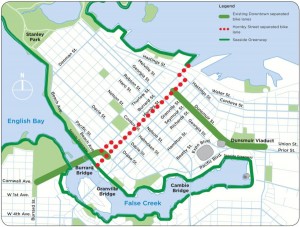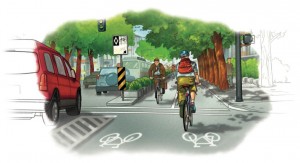The NWEP had a forum on urban transportation on November 9th, with several speakers touching on various topics realted to the evitable shift to more sustainable transportation. This is the first in a series summarizing some of the topics.
The first speaker was Jerry Dobrovolny, the Director of Transportation for the City of Vancouver. He also happens to be a New Westminster Resident, and was once a City Councillor here in Richmond. He spoke on two topics wrapped in one title:
“How the Olympics and Separated Bike Lanes are helping Vancouver become the Greenest City in the world by 2020”.
First, on the bike lanes.

They are also not new, but reflect what is quickly becoming the “standard” for road construction in urban areas, in Montreal, in New York, in Portland… Not to mix metaphors, but we aren’t reinventing the wheel here.
And it works. The money being spent on these cycling improvements in Vancouver is about $4 Million, out of annual transportation budget of about $125 Million, so about 3% of the budget. But in the downtown core where these improvements are happening, around 12% of all trips are by bicycle. Cyclists are no using roads they don’t pay for (roads are overwhelmingly financed by property taxes), they are actually subsidising other road improvemetns by a factor of four.
Yes, a few parking spots were lost on Hornby; 158 spots in total. However, as part of the program, 162 spots were added to Howe and Seymour Streets (one and three blocks away, respectively), which pales in comparison to the 10,000 off-street parking spots available within 1 block of the Hornby Street bike lane. If you survey people on Hornby, you would find 90% of them walked more than 2 blocks to get to their desination. In other words, the parking issue is another non-issue.
I wish Big, Fat, David Pratt and professional blowhard Bruce Allen were challenged with some facts for a change. Alas, that isn’t their job, is it?
